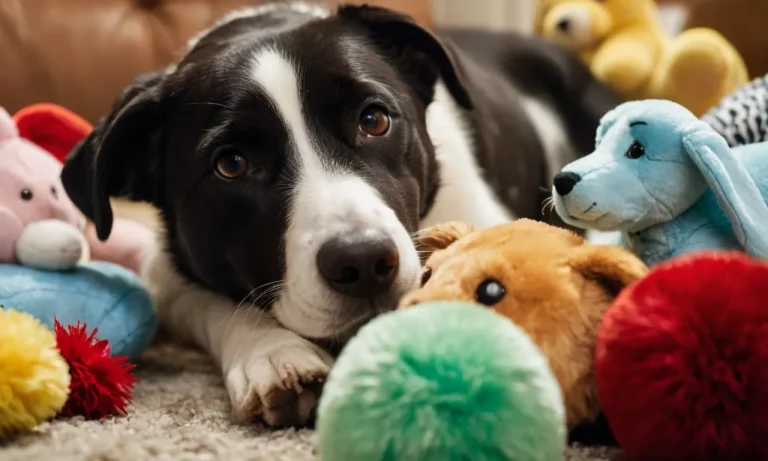Do you have a beloved stuffed animal collection that is starting to take over your room? A stuffed animal net is the perfect solution to neatly store and display your plush pals while saving valuable space.
If you’re short on time, here’s a quick answer to your question: To hang a net for stuffed animals, you’ll need to choose a net size and material that works for your space and collection. Use sturdy hooks rated for the weight, spaced close enough to prevent sagging.
Hang from ceiling, wall, beams, or a free-standing frame. Secure edges so animals don’t fall out. Put heaviest plushes near bottom.
In this comprehensive guide, we will cover everything you need to know about safely and attractively hanging stuffed animal nets so you can keep your collection tidy and prevent damage.
Choosing a Stuffed Animal Net
Net sizing based on your needs
When selecting a stuffed animal net, first consider the size and quantity of plush toys you want to display. Nets come in various dimensions from small to extra-large. Measure the area where you plan to hang the net and the dimensions of your largest stuffed animals to ensure proper fit.
An oversized net allows for future expansion of your collection. However, an undersized net won’t adequately showcase your treasured plushies.
Net material and strength considerations
Stuffed animal nets are commonly constructed using cotton, nylon, or microfiber fabric. Cotton offers a soft, comforting aesthetic. Nylon and microfiber provide exceptional durability. Assess the total weight of your plushies – heavier collections require reinforced netting material to prevent stretching over time.
Safety is also paramount. Opt for thick straps and fasteners that securely attach the net to walls or ceilings. Review weight ratings and manufacturer guidelines to guarantee safe usage.
Flat or pocket net style
Stuffed animal nets come in flat or pocketed designs. Flat nets evenly disperse plushies and are easier to install. However, items may slip around. Pocket nets feature individual compartments to hold each stuffed friend in place, keeping your collection neatly organized.
Consider your display goals and room layout when deciding between styles.
| Net Type | Pros | Cons |
|---|---|---|
| Flat | Easier to install | Plushies may move around |
| Holds plushies in place | Harder to install |
Selecting Hanging Hardware
Weight limits for hooks and anchors
When choosing hardware to hang your stuffed animal net, it’s crucial to select hooks and anchors that can securely support the total weight. Most standard hooks and anchors have weight limits between 50-100 lbs. Exceeding these limits risks the hardware ripping out of the wall or ceiling.
For lightweight stuffed animal nets under 30 lbs, you can likely use common hardware like Command hooks or small screw hooks. However, heavier nets require more reinforced hardware.
Hook and anchor types
When selecting hardware, consider what you’re hanging from – wall or ceiling. For walls, screw-in drywall anchors combined with hooks provide reliable strength. Just ensure the anchor’s weight limit meets your needs.
For ceilings, eye screws screwed into a ceiling joist work well for dispersing weight.
You’ll also need to choose between fixed or adjustable hanging hooks. Fixed hooks like screw or bolt hooks stay in one position. Adjustable hooks use a sliding mechanism, allowing you to raise or lower the height after mounting.
Spacing hooks properly
No matter how strong your hardware, improperly spaced hooks can cause sagging issues. As a rule of thumb, place hooks/anchors every 12-16 inches along your stuffed animal net to evenly distribute weight. For larger nets, space hooks even closer at 8-10 inches.
Additionally, always install end hooks just 2-3 inches from the net’s edges rather than centering them. This prevents the outer edges from drooping. Consider adding 1-2 extra center hooks for very wide nets to further prevent sagging.
| Net Weight | Hook Spacing Guide |
| Under 30 lbs | Every 16 inches |
| 30-50 lbs | Every 12-14 inches |
| Over 50 lbs | Every 8-10 inches |
Following these spacing and placement tips as you select and install hardware ensures your adorable stuffed critters stay up and on display with your awesome net!
Hanging Placement and Techniques
Wall versus ceiling versus stand hanging
When deciding where to hang your stuffed animal net, you have a few good options to consider. Wall hanging is great if you have an empty wall space to decorate. This highlights your stuffed critters as a fun focal point.
Ceiling hanging works wonderfully in places like bedrooms or playrooms where there’s open overhead space. The stuffed animals can dangle delicately above for a whimsical effect. For more versatility, hanging your net from a free-standing stand gives you the flexibility to move it around and place anywhere you like.
This portability lets you change up the decor down the line.
Reinforcing edges and seams
Once you’ve picked the perfect hanging placement, it’s wise to reinforce your net’s vulnerable spots. Focus extra attention on reinforcing edges prone to fraying. Try hand-sewing a sturdy border using strong upholstery thread and a thick needle before hanging up your net.
This helps prevent tears over time. Additionally, double check existing seams and knots to make sure your netting is securely closed everywhere. Redistribute stuffies around the mesh if certain areas seem overloaded.
This prevents undue stress leading to ripped seams from the stuffed animals’ weight down the road. Taking these preventative steps ahead ensures your taxidermy-style net stays structurally intact for seasons of enjoyment.
Preventing stuffed animals from falling out
Losing a beloved stuffed pal overboard is a bummer no one wants. Luckily some smart design choices can greatly reduce the chances of gravity claiming your favorite fluffy friend! Select a sturdy mesh size where the openings are not large enough for stuffed limbs to fit through.
Ideally you should have to gently squeeze stuffed animals through the holes during net assembly. Also cross-stitch shut any gaps around the border seams to seal off potential escape hatches. Finally, use color-coordinated strands of ribbon pinned to individual animals then tied to net knots.
This decorative tethering keeps cherished critters anchored in while still allowing them to artfully drape. Follow these tips and you can comfortably cuddle up with the comforting knowledge your sweet squishy stuffies are securely staying put right where they belong!
Filling and Arranging Your Net
Heaviest plushies near bottom
When filling your stuffed animal net, it’s important to put the heaviest plushies towards the bottom. This helps stabilize the net and prevents it from becoming top-heavy over time. Generally, larger stuffed animals like jumbo teddy bears, giant pandas, and life-sized animals should go on the bottom two shelves.
This provides a sturdy base that can easily support smaller and lighter stuffed animals placed higher up.
Mid-size plushies like regular teddy bears, medium-sized dogs or cats, and anything from 10-16 inches work well for the middle shelves. Finally, the lightest and smallest stuffed toys like beanie babies, keychains, and miniatures are perfect for the top one or two shelves.
Creative color schemes
Arranging your net by color can create a vibrant rainbow stuffed animal display. Some possibilities include:
- Roy G Biv arrangement with red plushies at the top graduating to orange, yellow, green, blue, indigo, and purple towards the bottom.
- Monochrome color scheme with different shades of a single color such as pink or blue.
- Alternating warm and cool colors shelf by shelf.
You can also organize more randomly by color and allow different hues to mingle. This tends to have a fun, playful effect. No matter what colors you have, embrace the diversity – it’s part of what makes each person’s collection unique!
| Color Scheme Idea | Example Layout |
|---|---|
| Rainbow | Red shelf, orange shelf, yellow shelf, green shelf, blue shelf, purple shelf |
| Monochrome | Light pink shelf, medium pink shelf, dark pink shelf |
| Warm and Cool Colors | Red shelf, blue shelf, orange shelf, green shelf, yellow shelf, purple shelf |
Leaving room for new additions
As any stuffed animal collector knows, the collection is likely to grow over time. When organizing your net, be sure to leave some open spaces for future acquisitions! Here are some tips:
- Only fill 75-85% of the shelves at first.
- If shelves start getting cramped, reorganize by consolidating to open up new areas.
- Add new high-up small shelves over time for expansion room.
It’s exciting when a new plushie friend can be incorporated into the main net display. Leaving room for more allows your collection to grow and evolve. Like friendships, some stuffed animal groupings just seem meant to be together!
For more tips, see the Plush Memories display guide or the Magical Stuffed Animals ideas post. With a bit of planning, you’ll have the perfect stuffed animal net in no time!
Conclusion
Hanging a stuffed animal net is an easy DIY project that can add personality to your space and keep your collection organized. With the right net size and material, securely installed hardware rated for the weight, and some planning for optimal arrangement, you’ll have a custom display that showcases your most treasured plush pals.
Just remember—reinforce edges, space hooks to prevent sagging, put heaviest animals near bottom, and leave room for new members of the gang. Happy hanging!







